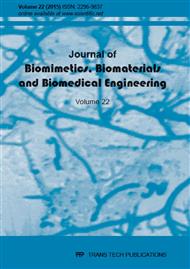[1]
R.A. Mann, M.J. Coughlin, Hallux valgus: etiology, anatomy, treatment and surgical considerations, Clinical Orthopedics (1981), 15, 31-41.
DOI: 10.1097/00003086-198106000-00008
Google Scholar
[2]
C. Saro, B. Andren, T. L. Fellander, U. Lindgren, A. Arndt, Plantar pressure distribution and pain after distal osteotomy for hallux valgus: a prospective study of 22 patients with 12-month follow-up, The Foot. (2007), 17, 84-93.
DOI: 10.1016/j.foot.2006.11.002
Google Scholar
[3]
T.J. Lorei, C. Kinast, H. Klarner, D. Rosenbaum, Petrographic, clinical and functional outcome after Scarf osteotomy, Clinical Orthopedics and Related Research (2006), 451, 161-166.
DOI: 10.1097/01.blo.0000229297.29345.09
Google Scholar
[4]
S. Srivastava, N. C. lingam, T. Fakhri, Radiographic measurements of hallux angles: a review of current techniques, The Foot. (2010), 20(1) 27-31.
DOI: 10.1016/j.foot.2009.12.002
Google Scholar
[5]
H.B. Menz, S.E. Munteanu, Radiographic validation of the Manchester scale for the classification of hallux valgus deformity, Rheumatology (2005), 44, 1061-1066.
DOI: 10.1093/rheumatology/keh687
Google Scholar
[6]
E. Roddy, W. Zhang, M. Doherty, Prevalence and associations of hallux valgus in a primary care population, Arthritis Rheum (2008), 59, 857-862.
DOI: 10.1002/art.23709
Google Scholar
[7]
M. Yavuz, V.J. Hetherington, G. Botek, G.B. Hirschman, L. Bardsley, B.L. Davis, Forefoot plantar shear stress distribution in hallux valgus patients, Gait Posture (2009), 30(2), 257-259.
DOI: 10.1016/j.gaitpost.2009.05.002
Google Scholar
[8]
M. Blomgren, I. Turan, M. Agadir, Gait analysis in hallux valgus, The Journal of Foot Surgery (1991), 30(1), 70-71.
Google Scholar
[9]
W.C. Hutton, M. Dhanendran, The mechanics of normal and hallux valgus feet-a quantitative study, Clinical Orthopedics and Related Research (1981), 157, 7-13.
DOI: 10.1097/00003086-198106000-00004
Google Scholar
[10]
A. Bryant, P. Tinley, K. Singer, Plantar pressure distribution in normal: hallux valgus and hallux limitus feet, The Foot (1999), 9(3), 115-119.
DOI: 10.1054/foot.1999.0538
Google Scholar
[11]
N.A. Martinez, R.R. Sanchez, B.S. Perez, L.A. Leal, Z. J. Pedrera, Plantar pressures determinants in mild Hallux Valgus, Gait & Posture (2010), 32(3), 425-427.
DOI: 10.1016/j.gaitpost.2010.06.015
Google Scholar
[12]
J. Taranto, M.J. Taranto, A.R. Bryant, K.P. Singer, Analysis of dynamic angle of gait and radiographic features in subjects with hallux abductor valgus and hallux limits, Journal of the American Podiatric Medical Association (2007), 97(3), 175.
DOI: 10.7547/0970175
Google Scholar
[13]
M. Nyska, A. Liberson, C. McCabe, K. Linge, L. Klenerman, Plantar foot pressure distribution in patients with hallux valgus treated by distal soft tissue procedure and proximal metatarsal osteotomy, Foot and Ankle Surgery (1998), 4(1), 35-41.
DOI: 10.1046/j.1460-9584.1998.00068.x
Google Scholar
[14]
I.A. Stokes, W.C. Hutton, J.R. Stott, L.W. Lowe, Forces under the hallux valgus foot before and after surgery, Clinical Orthopedics and Related Research (1979), 142, 64-72.
DOI: 10.1097/00003086-197907000-00011
Google Scholar
[15]
A. Mapelli, V. Colangelo, F. Sidequersky, I. Annoni, B. Lenci, and C. Sforza, Effect of high-heeled shoes on three-dimensional body COM displacement during walking, Gait & Posture (2012), 35, 33-34.
DOI: 10.1016/j.gaitpost.2011.09.067
Google Scholar
[16]
T.S. Keller, A.M. Weisberger, J.L. Ray, S.S. Hasan, R.G. Shiavi, D.M. Spengler, Relationship between vertical ground reaction force and speed during walking, slow jogging, and running, Clinical Biomechanics (1996), 11(5), 253-258.
DOI: 10.1016/0268-0033(95)00068-2
Google Scholar
[17]
J. Stebbins, M. Harrington, N. Thompson, A. Zavatsky, T. Theologis, Repeatability of a model for measuring multi-segment foot kinematics in children, Gait Posture (2006), 23, 401-410.
DOI: 10.1016/j.gaitpost.2005.03.002
Google Scholar
[18]
F.L. Li, Y. Zhang, Y.D. Gu. Lower extremity mechanics of jogging in different experienced high-heeled shoe wearers, Int. J. Biomedical Engineering and Technology (2014), 15(1), 59-68.
DOI: 10.1504/ijbet.2014.060991
Google Scholar
[19]
S. Ahlack, Osteoarthritis of the knee-a radio graphic investigation, Acta Radiological Diagnosis (1968), 277, 70-72.
Google Scholar
[20]
D.T. Felson, E.L. Radi, What causes knee osteoarthritis: are different compartments susceptible to different risk factors? Journal of Rheumatology (1994), 21 (2), 181-183.
Google Scholar
[21]
J. T. Dearborn, C. L. Eakinakin, H. B. Skinner, Medial compartment arthrosis of the knee, American Journal of Orthopedics (1996), 25 (1), 18-26.
Google Scholar
[22]
A. J. Baliunas, et al., Increased knee joint loads during walking are present in subjects with knee osteoarthritis, Osteoarthritis and Cartilage (2002), 10 (7), 573-579.
DOI: 10.1053/joca.2002.0797
Google Scholar
[23]
U. Kanatli, A.M. Ozturk, N.G. Ercan, M. Ozalay, B. Daglar, H. Yetkin, Absence of the medial sesamoid bone associated with metatarsophalangeal pain, Clin Anat. (2006), 19, 634-639.
DOI: 10.1002/ca.20282
Google Scholar
[24]
T.H. Williams, C. Pasapula, A.H. Robinson, Complete sesamoid agenesis: a rare cause of first ray metatarsalgia, Foot Ankle Int. (2009), 30, 465-467.
DOI: 10.3113/fai-2009-0465
Google Scholar
[25]
C.J. Snijders, J.G. Snijder, and M.M. Philippens, Biomechanics of hallux valgus and spread foot, Foot Ankle (1986), 7, 26-39.
DOI: 10.1177/107110078600700106
Google Scholar
[26]
I.A. Stokes, W.C. Hutton, and J.R. Stott, Forces acting on the metatarsals during normal walking, Anat. (1979), 129, 579-590.
Google Scholar
[27]
W.C. Hutton, and M. Dhanendran, The mechanics of normal and hallux valgus feet: a quantitative study, Clinical Orthopedics (1981), 157, 7-13.
DOI: 10.1097/00003086-198106000-00004
Google Scholar
[28]
H. Yamamoto, T. Muneta, S. Asahina, and K. Furuya, Forefoot pressures during walking in feet afflicted with hallux valgus, Clinical Orthopedics (1996), 323, 247-253.
DOI: 10.1097/00003086-199602000-00034
Google Scholar
[29]
U. Waldecker, Metatarsalgia in hallux valgus deformity: a petrographic analysis, Journal of Foot and Ankle Surgery (2002), 41(5), 300-308.
DOI: 10.1016/s1067-2516(02)80048-5
Google Scholar
[30]
N. A Martinez, R. R Sanchez, S. P. Perez, B. S Llana, M. A. Leal, Z. J. Pedrera, Plantar pressures determinants in mild Hallux Valgus, Gait & Posture (2010), 32(3), 425-427.
DOI: 10.1016/j.gaitpost.2010.06.015
Google Scholar
[31]
M. Plank, The pattern of forefoot pressure distribution in hallux valgus, The Foot (1995), 5(1), 8-14.
DOI: 10.1016/0958-2592(95)90026-8
Google Scholar
[32]
U. Waldecker, Pedographic analysis of hallux valgus deformity, Foot and Ankle Surgery (2004), 10(3), 121-124.
DOI: 10.1016/j.fas.2004.03.004
Google Scholar


